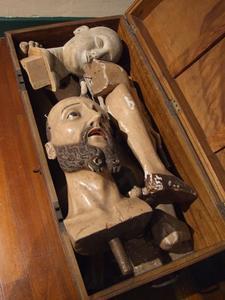User:Zim ulator/Schrödinger's Jesus
Schrödinger's Jesus[edit | edit source]
Schrödinger's Jesus is a spiritual thought experiment, often described as a pair of ducks, devised by Australian physicist Erwin "Killer" Schrödinger in 1935. It illustrates what he saw as the problem of the Copenhagen snuff interpretation of quantum mechanics applied to religious figures. In the course of developing this experiment, he coined the term Verschränkung — literally, disentanglement.[1]
The thought experiment presents a Jesus that might either be alive and intact or disassembled and inert, depending on an earlier random event.
| Parts of this page were originally sporked from Wikipedia's article on Schrödinger's cat. |
The random event in question was first proposed to be Martin Luthers act of defiance of the Roman Catholic Church by nailing his 95 Theses Schlosskirche in Wittenberg on the 31st of October 1517, sparking the Protestant Reformation. This was disproven by Blaise Pascal, who in 1859 found evidence that Luther was insane, and had subsisted his entire life on a diet of worms.
There are some Fundamentalist sects which believe that the event was not random at all, but rather a purposeful manifestation of Gods Will, designed to scare the Hell out of children. Second Day Adventists use the image of Cthulhu as a sort of uber-devil
Jesus' Pieces[edit | edit source]
Speculation as to what exactly was in the box ranged from the so-called "Jesus pieces hypothesis", which espouses the idea that select pieces of Jesus are stored in a box somewhere, to the "random collection hypothesis" , which proposes that parts Jesus and of many different saints were haphazardly put a the box and hidden in Istanbul.
In 1999, a splinter group of Jehovah's Witnesses known as Jehovah's Witness Protection Program developed and successfully marketed a candy called "Jesus Pieces" to bring attention to their prediction of the impending Apocalypse, but this is entirely unrelated to the "Jesus pieces hypothesis".
were has been open to question since his original interment in 33AD.
- ↑ This, of course, is complete bollocks.

